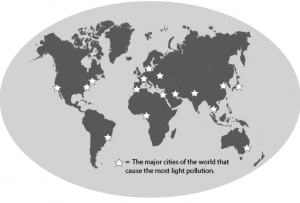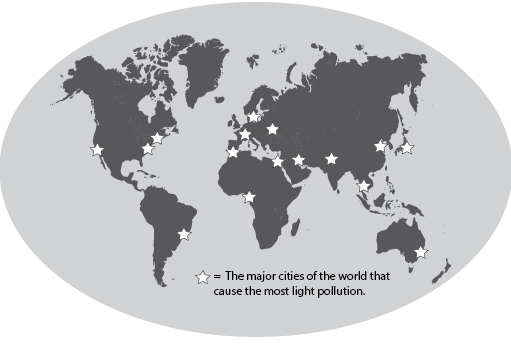 With hundreds of summer nights to look forward to after school gets out, one should be able to look up into the night sky and be awestruck by the sight of constellations. However, as we are located just outside of D.C. and in the bustling suburbs, the night sky is obscured by light from houses, buildings, and cars.
With hundreds of summer nights to look forward to after school gets out, one should be able to look up into the night sky and be awestruck by the sight of constellations. However, as we are located just outside of D.C. and in the bustling suburbs, the night sky is obscured by light from houses, buildings, and cars.
This is what scientists refer to as light pollution, the obtrusive artificial light that comes in three forms: glare, light trespass, and skyglow. The most common is skyglow, which is the accumulation of reflected light that shines into the sky, and is most obviously seen in highly populated areas.
An overwhelming one-fifth of the globe can’t see the Milky Way in our sky on any given night. Half of Europe can’t see the unaltered night sky, and even worse, two-thirds of the United States drowns the sky with light, according to Pierantonio Cinzano of The World Atlas of the Artificial Night Sky Brightness.
There is even a scale to determine how affected certain areas of sky are by artificial light, called the Bortle Scale. Areas of sky are ranked from Class One, the darkest skies, to Class Nine, which are the lightest night skies such as New York City. David Owen of the New Yorker, who has a Ph.D. in astronomy, estimates that the darkest places in the United States only rank up to a Class Two, and even those areas are slowly fading. The only places to truly see a Class One dark sky would be in the Australian outback or along a Peruvian mountain range.
Owen also states that we are able to see less than one percent of what Galileo Galilei, one of the most famous Renaissance astronomers, would have been able to see in the early seventeenth century.
What most people don’t realize is what they’re giving up due to this unnaturally intense amount of light. People that look up into the sky now are looking into an entirely different sky than the people who looked at it 150 years ago.
Yes, electricity and industrialization is necessary and a huge benefit to society, but the night sky has priceless intrinsic value incomparable to any other type of nature on the planet.
Light pollution also effects nocturnal wildlife, which depend on the natural lighting of the moon for their behavioral and survival patterns. According to Verlyn Klinkenborg of The National Geographic in 2008, long artificial days and short artificial nights affect migrations patterns in birds, which in turn botches nesting conditions.
Similarly, sea turtles depend on increasingly sparse dark beaches to lay their eggs on, and their hatchlings that must follow the reflective sea horizon into the water are becoming more disoriented by the artificial light behind beachfronts.
Obviously, eliminating electricity is neither practical nor possible. But that doesn’t mean there aren’t measures cities can take to reduce their light pollution. Reducing the uses of both outdoor lighting and indoor lights during night hours is the most obvious solution. However, those light fixtures that must be used at night can be redesigned to be directed more downward to reduce light refraction.
For anyone who has the time and the means to take a road trip to a less inhabited area, even if it’s just a couple of hours out in the countryside, by all means take it to enjoy a partially unaffected night sky.

